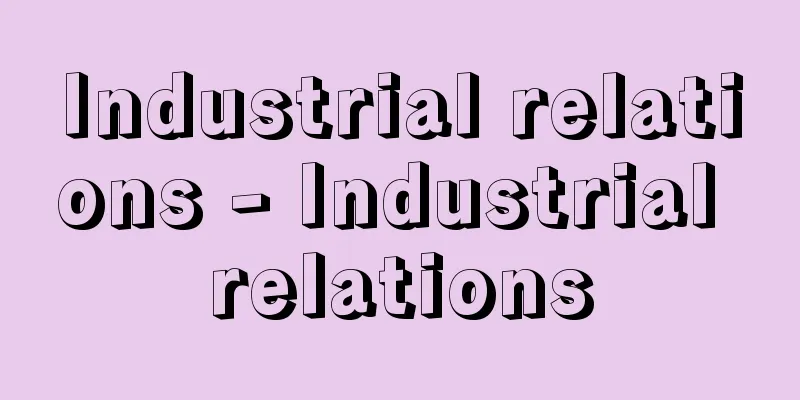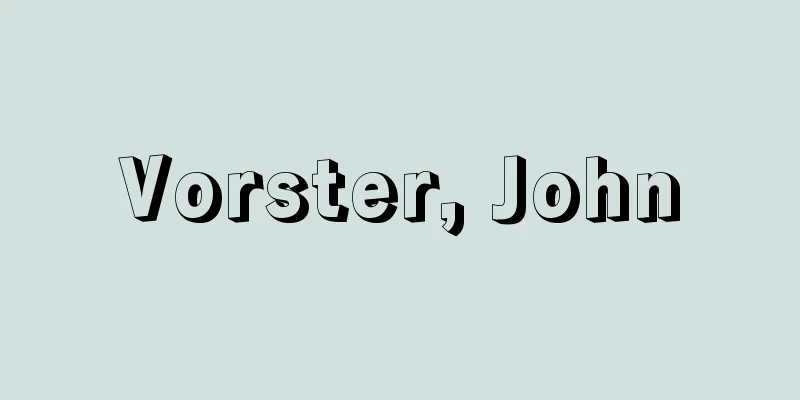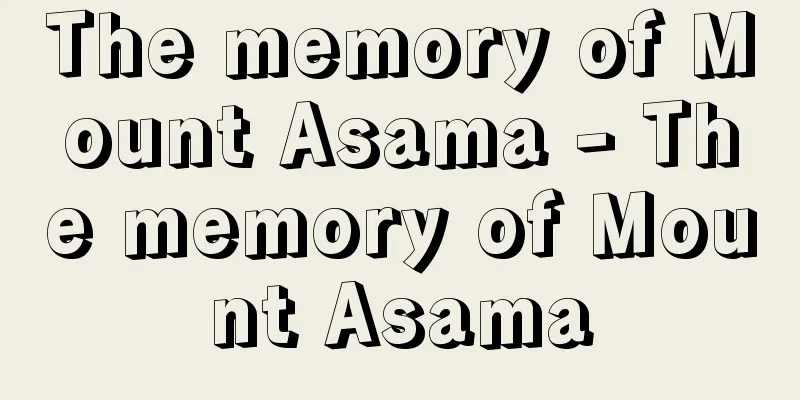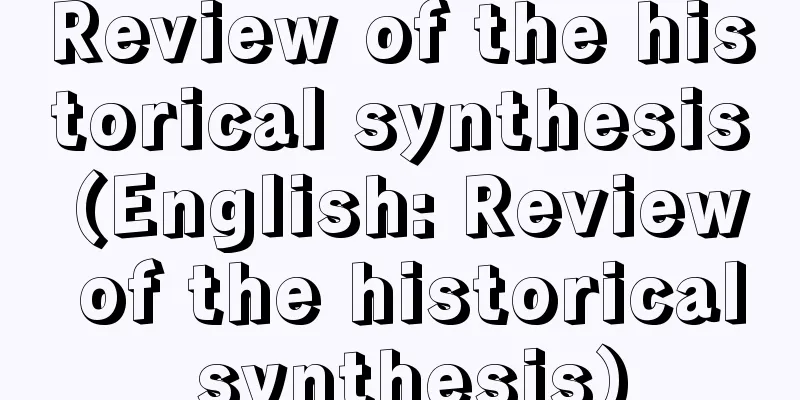Industrial relations - Industrial relations

|
The concept of labor-management relations was given to replace the fundamental contradiction and opposition between capital and wage labor, and between capitalists and workers in capitalist society, that is, labor-management relations, with the relationship between labor managers (employers, managers) and those managed by labor (workers, employees) in modern industrialized society. This term became universal in Japan after World War II. The term labor-management relations is said to have originated from the United States Commission on Industrial Relations (1912-1915), which held public hearings on the Taylor System. However, regardless of its origin, the concept of labor-management relations, along with the concept of management rights, was used, disseminated, and universalized after World War II, reflecting the intention of monopoly capital to control labor union movements as movements within the system. [Tokita Yoshihisa] A universal presence in industrial societyWhat are labor-management relations? John Thomas Dunlop (1914-2003), one of the leading proponents of the theory, wrote the following in the preface to his book Industrial Relations Systems (first published in 1958): "Every industrialized society, regardless of political form, produces workers and managers. The status and interrelationships of these workers and managers must be more or less precisely defined. Industrial societies inevitably produce labor-management relations that are defined as a complex of interrelationships between managers, workers, and government agencies." Thus, labor-management relations are universal in "industrial societies," regardless of whether they are capitalist or socialist. Under this concept, the conflictual relationship between exploiter and exploited, and between domination and rebellion, that is determined by the private ownership of the means of production in capitalism, is understood as the relationship between people with different functions based on the division of labor that accompanies "industrialization." In other words, the concept of labor-management relations conceals the true nature of the social relationship between capital and wage labor that is unique to capitalism - labor-management relations. In terms of form, labor-management relations are nothing more than a "free" buying and selling relationship of the labor power commodity, with the parties being the capitalist, the owner of the means of production, and the wage laborer, the owner of labor power. However, workers do not own the means of production, and are therefore "economically compelled" to sell their labor power to the capitalist, the owner of the means of production, and to receive a wage in order to survive. Moreover, in the process of labor power consumption by capitalists, that is, in the process of capital production, the capitalist commands and controls the workers, and exploits their surplus labor. Therefore, such labor-management relations cannot be replaced with the concept of labor-management relations. [Tokita Yoshihisa] Duality and dualityThe theory of labor-management relations that conceals labor-management relations takes issue with the dual nature and duality of labor-management relations as follows. The basis of all labor-management relations is the economic relationship of employment, but this employment relationship includes two relations. The first is the relationship related to the determination of employment conditions (labor relations in the narrow sense). This is an economic transactional relationship between capitalists and wage laborers over the buying and selling of labor in the labor market. It is the subject of collective bargaining by labor unions, and in the sense that it includes the rivalry between management and labor unions over the terms of labor transactions, the interests of the two parties are in conflict. The second is employee relations and personnel relations. Here, employers appear as managers and workers as employees, with managers as the ones responsible for business policies, plans, and control, and employees perform various administrative tasks and labor under their instructions. Therefore, both managers and employees work together as productive actors, and the labor-management consultation system can create a cooperative relationship rather than a conflictual one. What is the significance of preaching the duality and dual nature of labor-management relations and employment relations in this way? First, it defines labor unions as holders of the terms of trade for the labor commodity in the labor market, limits the subject of collective bargaining to the terms of trade for labor, and removes labor unions and the function of collective bargaining from companies and workplaces. In this way, the class oppositional relationship of labor unions against the despotic rule and exploitation of capital is reduced to a conflict over the "distribution of the pie" through collective bargaining. Moreover, secondly, the issue of "increasing the pie," which is the source of distribution, is dealt with through a labor-management consultation system in a forum for labor-management collaboration, and cooperation is expected between workers (labor unions) and employers to increase the size of the pie before fighting over its distribution (labor-management cooperationism). After the Second World War, the labor movement developed in both quality and quantity, the collective bargaining function of labor unions expanded, the labor union movement penetrated into companies and workplaces, and the expansion of workers' rights within companies became noticeable. In response to this worsening of labor-management relations, the theory of labor-management relations reflected the ideology and policy proposals of monopoly capital, which sought to defend management rights, integrate labor unions under economism and even cooperationism, and perpetuate the capital-wage labor relationship. [Tokita Yoshihisa] Japanese Labor RelationsIn a broad sense, labor-management relations refers to the general social relations that exist between workers and employers (management), but the core of these is the relationship between labor unions and management. In Japan, in terms of the relationship between labor unions and management, the presence of "company unions" has been noted, and together with the "lifetime employment" system and the "seniority-based wage" system, it has been characterized as "Japanese-style labor-management relations." In Western labor unions, the basic organizational units are by occupation and industry, and individual membership has been the norm. In contrast, since World War II, labor unions in Japan have often been organized as "enterprise unions" characterized by the collective membership of all regular employees, with the basic organizational units being the company or business establishment. "Enterprise unions" are affiliated to national umbrella organizations by industry and region, and have their own rules, policies, finances, and officers, so their vision tends to be limited to within the company, and they have organizational weaknesses in that they find it difficult to engage in cross-company negotiations or class-based joint action in labor transactions. After the Second World War, Japan's labor unions did indeed start out organized by business establishment and company, but in August 1946, the All-Japan Industrial Trade Union Congress (abbreviated as Sanbetsu Kaigi, with 1.56 million members at the time of its establishment) was formed and led to the rapid development of single industrial labor unions. However, this transformation from company-based organizations to industrial organizations was thwarted by policies implemented by the American occupation forces and the political and business worlds, such as the deprivation of the right to strike from government workers (1948), the Red Purge (1950), the formation of the General Council of Japanese Trade Unions (abbreviated as Sohyo) and the dissolution of the Sanbetsu Kaigi. Later, in the mid-1960s, supported by the establishment of "lifetime employment" and "seniority-based wages" against the backdrop of rapid economic growth, "enterprise unions" based on the principle of labor-management cooperation took root, especially in large companies. "Lifetime employment," "seniority-based wages," and "enterprise unions" have long been considered the foundations of stable labor-management relations within Japanese companies, and in the 1980s, "Japanese-style labor-management relations," characterized by these three features, were praised as the driving force and resource behind the rapid growth of Japanese companies and their transformation into an "economic superpower," attracting international attention. However, in the 1990s, faced with a long recession, economic globalization by multinational corporations, and the advent of an age of intense competition, "Japanese-style labor-management relations" also reached a major turning point. In order to cope with the economic upheaval and reduce total labor costs, large Japanese companies are promoting ME (microelectronics), IT (information technology) revolution, and so-called restructuring or "rationalization" under the government's deregulation policy, and above all, they are pursuing a drastic reduction in regular employment and the replacement and expansion of non-regular employment (part-time, temporary/contract workers, external contractors, etc.). However, this so-called "employment flexibility" has also led to the dismantling of "lifetime employment" and "seniority-based wages," and the weakening of "enterprise unions," and the foundations of "Japanese-style labor-management relations" are now being shaken to a great extent. Under these conditions, the issue of how to reconstruct labor-management relations based on the respective positions and interests of both labor and management has become a hot topic. [Tokita Yoshihisa] "Industrial Relations and the Industrial Consultation System" by Fujibayashi Keizo (1963, Diamond Inc.) ▽ "Industrialism: Management and Labor in Industrialization" by J.T. Dunlop, F.H. Harbison, et al., supervised by Nakayama Ichiro, translated by Kawada Hisashi (1963, Toyo Keizai Shinposha)" ▽ "Comprehensive Management Accounting Book 9: Industrial Relations Theory" edited by Kimoto Shinichiro (1976, Nippon Hyoronsha) ▽ "Development of the Industrial Relations System: The Implications of Japan's Experience" edited by OECD and translated by the Japan Labor Association (1977, Japan Labor Association)" ▽ "Modern Japanese Companies and Industrial Relations" edited by Hasegawa Hiroshi (1981, Labor Junposha) ▽ "Unsettling 'Japanese-style Industrial Relations'" edited by Kimoto Shinichiro and compiled by the General Institute of Labor Movement (1995, Shin Nihon Shuppansha)" ▽ "Globalization and Japanese-style Labor-Management Relations" edited by Yoichi Aizawa and Kenichi Kuroda (2000, Shinnihon Shuppansha) " ▽ "Company-specific Unions" by Taishiro Shirai, revised edition (Chuko Shinsho) [References] | | | | | | | | | | | | | | | |Source: Shogakukan Encyclopedia Nipponica About Encyclopedia Nipponica Information | Legend |
|
資本主義社会における資本と賃労働、資本家と労働者との基本的な矛盾・対抗関係、すなわち労資関係を、近代的な工業化された社会における労働の管理者(使用者、経営者)と労働の被管理者(労働者、従業員)との関係に置き換え、これに労使関係という概念が与えられるようになった。この用語が日本で普遍化したのは第二次世界大戦後のことである。労使関係という用語は、テーラー・システムに関する公聴会を開いたアメリカの「労使関係委員会」The United States Commission on Industrial Relations(1912~1915)に発するといわれる。だが、その源流はともあれ、労使関係という概念は、経営権という概念とともに第二次世界大戦後、労働組合運動を体制内運動として管理しようとする独占資本の意図を反映して使用され、普及され、普遍化されたといってよい。 [戸木田嘉久] 産業社会の普遍的存在労使関係とはなにか。代表的な論者のひとりであるJ・T・ダンロップJohn Thomas Dunlop(1914―2003)は、『労使関係制度論』(原題はIndustrial Relations Systems. 初版1958年)の序文で次のように書いている。「政治形態のいかんを問わず、あらゆる産業化した社会は労働者と経営者をつくりだす。これら労働者と経営者の地位とその相互関係は、多かれ少なかれ詳細に規定されねばならなくなる。産業社会は必然的に経営者と労働者と政府機関の相互関係との複合体として規定された労使関係をつくりだす」。このように労使関係は、「産業社会」では資本主義、社会主義の区別なく普遍的に存在する。この概念のもとでは、生産手段の私的所有形態によって規定された資本主義の搾取と被搾取、支配と反抗の対立関係が、「産業化」に伴う分業に基づく機能を異にする人々の相互間の関係として把握される。 つまり労使関係という概念は、資本主義に固有な資本と賃労働との社会的関係=労資関係の本質を隠蔽(いんぺい)するものである。労資関係は、その形式からみれば、生産手段の所有者である資本家と、労働力の所有者である賃金労働者とを当事者とする、労働力商品の「自由な」売買関係にほかならない。しかし、労働者は生産手段を所有せず、したがって、自分の労働力を生産手段の所有者である資本家に販売し、賃金を取得しない限り生活できないという「経済的強制」を受けている。しかも、資本家による労働力の消費過程、すなわち資本の生産過程においては、資本家は労働者を指揮・統制し、労働者の剰余労働を搾取する。したがって、このような労資関係を労使関係という概念に置き換えることはできない。 [戸木田嘉久] 二元性と二重性労資関係を隠蔽する労使関係論では、次のように労使関係の二元性・二重性が問題にされる。すべての労使関係の基礎をなすのは雇用という経済的関係であるが、この雇用関係には二つの関係が含まれるというのである。第一は、雇用条件の決定にかかわる関係(狭義の労使関係labour relations)である。これは資本家と賃金労働者の労働市場における労働力の売買をめぐる経済的取引関係である。それは労働組合による団体交渉の対象領域であり、労働力の取引条件をめぐる経営と労働組合の対抗を含むという意味では、両者の利害は対立する関係にある。第二は、従業関係employee relations, personnel relationsである。ここでは雇主は経営者、労働者は従業員として現れ、経営者は事業の方針、計画、統制などの担い手であり、従業員はその指示のもとでさまざまな事務や労働を行う。したがってそこでは、経営者も従業員も生産活動の担い手としてともに働く関係にあり、労使協議制によって対立関係ではなく協力関係をつくりだすこともできる、というわけである。 このように労使関係・雇用関係の二元性・二重性が説かれる意義はどにあるのか。それは第一に、労働組合を労働市場における労働力商品の取引条件の担い手と規定し、団体交渉の対象を労働力の取引条件に限定し、労働組合および団体交渉機能を企業および職場内から排除するものである。そこでは、資本の専制的支配と搾取に対する労働組合の階級的対抗関係は、団体交渉による「パイの分配」をめぐる対立に矮小(わいしょう)化される。しかも、第二に、その分配源資である「パイの増大」の問題は、労使協働の場で労使協議制によって扱われ、パイの分配を争う以前にパイの増大を図るための、労働者=労働組合と使用者の協調が期待される(労使協調主義)、というわけである。 第二次世界大戦後、労働運動は質・量にわたる発展を遂げ、労働組合の団体交渉機能は拡大され、労働組合運動の企業および職場内への浸透、企業内における労働者の権利の拡大が目だつようになった。労使関係論は、このような労資関係の深刻化に対応して、経営権の防衛を図り、労働組合を経済主義、さらには協調主義のもとに統合し、資本・賃労働関係を永続化せしめようとする独占資本のイデオロギー、および政策的提言を反映したものである。 [戸木田嘉久] 日本的労使関係労使関係とは、広義には労働者と使用者(経営者)の間に成り立っている社会関係一般を意味するが、その中核となるのは労働組合と経営者との関係である。労働組合と経営者との関係という意味で、日本の労使関係においては、「企業別組合」の所在が着目され、さらに「終身雇用」制、「年功賃金」制と合わせて、「日本的労使関係」という特徴づけが行われてきた。 欧米の労働組合では、職業別、産業別を基本的な組織単位とし、個人加盟が建前とされてきた。これに対し、第二次世界大戦後日本の労働組合は、多くの場合に組織の基本単位が企業別、事業所別で、正規雇用従業員の一括加盟を特徴とする「企業別組合」として定着してきた。「企業別組合」は、産業別・地域別に全国的な上部団体に加盟しており、独自の規約、方針、財政、役員をもつことから、その視野は企業内に限られがちで、労働力取引の企業を超えた横断的交渉や階級的共同行動がとりにくいという組織的弱点がみられる。 第二次世界大戦後、日本の労働組合組織は、確かに事業所ごと企業別に組織されるところから出発したが、1946年8月、全日本産業別労働組合会議(略称、産別会議、結成当時156万人)の結成と指導によって、早急に産業別単一労働組合への発展を指向した。しかし、この企業別組織から産業別組織への脱皮は、官公庁労働者からのストライキ権剥奪(1948年)、レッド・パージ(1950年)、日本労働組合総評議会(略称、総評)の結成と産別会議の解体など、アメリカ占領軍と政財界一体の政策によって阻止された。その後、1960年代なかば、高度経済成長を背景とした「終身雇用」「年功賃金」の確立に支えられ、とりわけ大企業を中心に労使協調主義的な「企業別組合」が定着したといえよう。 「終身雇用」「年功賃金」「企業別組合」は、つとに日本の企業内労資関係安定の基礎とされ、1980年代には、この三つを特質とする「日本的労使関係」こそ日本企業の急成長、「経済大国」化の「原動力」「資源」などとたたえられ、国際的にも注目されてきた。しかし、1990年代に入ると、長期不況、多国籍企業による経済のグローバル化、大競争時代の到来に直面して、「日本的労使関係」も大きな転換点に立たされている。 経済的激動の時代に対処し総額人件費を節約するため、日本の大企業では、国の規制緩和政策のもとで、ME(マイクロエレクトロニクス)化、IT(情報技術)革命、そしていわゆるリストラ「合理化」を大々的に進め、なによりも正規雇用の大幅な削減、非正規雇用(パートタイム、派遣・契約社員、外部請負など)への入替え・拡大が追求されている。しかし、このいわゆる「雇用の弾力化」は、「終身雇用」「年功賃金」の解体、「企業別組合」の弱体化にもつながり、いまや「日本的労使関係」の基盤は大きく動揺しつつある。こうした条件のもとで、労資双方にとって、それぞれの立場と利害のうえに立ち、労資関係をどのように再構成するかが集眉の課題となっている。 [戸木田嘉久] 『藤林敬三著『労使関係と労使協議制』(1963・ダイヤモンド社)』▽『J・T・ダンロップ、F・H・ハービソン他著、中山伊知郎監修、川田寿訳『インダストリアリズム――工業化における経営者と労働』(1963・東洋経済新報社)』▽『木元進一郎編著『経営会計全書9 労使関係論』(1976・日本評論社)』▽『OECD編、日本労働協会訳編『労使関係制度の展開――日本の経験の意味するもの』(1977・日本労働協会)』▽『長谷川広編『現代日本企業と労使関係』(1981・労働旬報社)』▽『木元進一郎監修、労働運動総合研究所編『動揺する「日本的労使関係」』(1995・新日本出版社)』▽『相沢与一・黒田兼一監修『グローバリゼーションと「日本的労使関係」』(2000・新日本出版社)』▽『白井泰四郎著『企業別組合』増訂版(中公新書)』 [参照項目] | | | | | | | | | | | | | | | |出典 小学館 日本大百科全書(ニッポニカ)日本大百科全書(ニッポニカ)について 情報 | 凡例 |
>>: The theory of Laozi becoming a shy person
Recommend
Kineya Rokuou
…Other compositions he composed include “Sarashim...
Book of Malachi (English spelling) Mal'ākî (Hebrew)
This is the last book of the twelve minor prophet...
light-indifferent seed
...After-ripening is the phenomenon in which dorm...
Tektite - tektite (English spelling)
A dark brown glassy substance in the shape of a s...
Boudin, Eugène
Born: July 12, 1824, Honfleur [Died] August 8, 189...
Libel law - Zambouritsu
Japan's first independent libel law was promu...
Xhosa; Xosa
A Bantu-speaking ethnic group in the southernmost ...
Shioya-shi
A medieval samurai family in Izumo. A branch of th...
Gonçalves, Nuno
Portuguese painter of the 15th century. He was act...
Action movie
[Action films as the starting point of Japanese f...
Right to pursue happiness
One of the fundamental human rights guaranteed in...
Truth and Fiction
〘Noun〙① Something that has no substance and someth...
IMF Article 8 nation - IMF Hachijokoku (English spelling) Article 8 nation of IMF
International Monetary Fund A country that has acc...
Sadayoshi Kaji - Sadayoshi Kaji
1612-1698 A samurai from the early Edo period. Bo...
Kamae (plant) - Kamae
...And with each rain, grass sprouts and flowers ...









